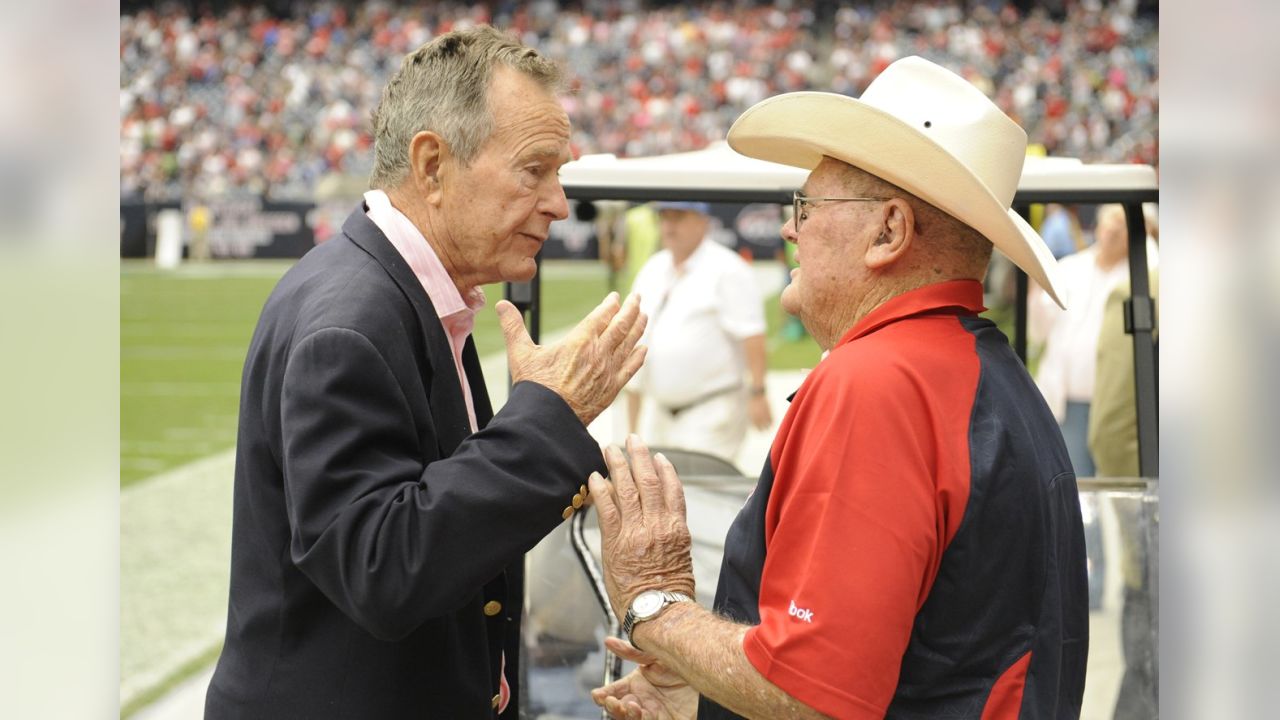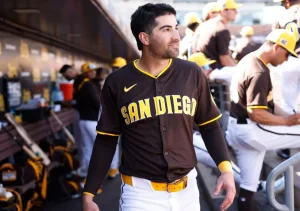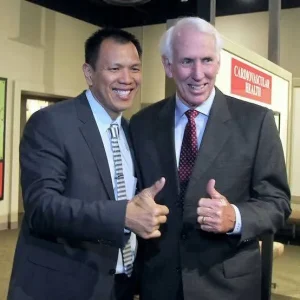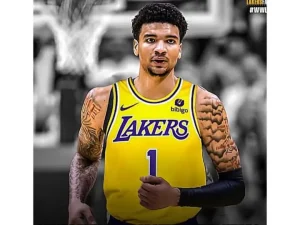
How Oilers’ salary cap and Raphael Lavoie’s contract could impact his future
How Oilers’ salary cap and Raphael Lavoie’s contract could impact his future
It seems no player at Edmonton Oilers training camp has caused as much consternation among the fan base as Raphael Lavoie. Probably for good reason.
There’s basically one roster spot up for grabs and Lavoie, a 23-year-old drafted-and-developed prospect, is battling with a few guys invited to camp on tryouts. If he can’t win the job, Lavoie will require waivers for the first time in his career — which could end his Oilers career before it really begins.
Lavoie has performed fine while appearing in two of Edmonton’s first four preseason games — the second of which came Friday in Calgary. There’s still more runway left.
Regardless, it should be an easy decision: keep the young player with upside. It’s not so simple. The Oilers are in a cap and numbers crunch, so Lavoie’s chances to make the Oilers are in doubt.
This is how the situation got to this point and what could come next.
How did the Bouchard and McLeod contracts impact Lavoie?
It’s no secret the Oilers will start the season with 21 players — which includes the bare minimum of 12 forwards. Only a trade or a stint on LTIR from a veteran player will change that.
That wasn’t the intended plan. GM Ken Holland told The Athletic before the NHL Draft in June that he wanted to carry a 22-man roster with an extra forward and defenceman aboard. Yet, despite ditching Kailer Yamamoto’s $3.1 million cap hit and replacing him with Connor Brown’s league-minimum salary, that almost certainly won’t be the case.
What it comes down to — at least strictly in terms of summertime moves — is giving Evan Bouchard and Ryan McLeod an extra year on their contracts as restricted free agents.
Per PuckPedia, the Oilers have $283,374 in cap space with Lavoie on the roster as the 12th forward in place of Lane Pederson — the only player in the running for the job with a contract.
The Oilers were budgeting anywhere between a $1.75 million to $2.25 million cap hit for McLeod, so to get him signed for $2.1 million AAV for two years seems like good business. A one-year deal would have lowered the salary slightly, theoretically by as much as $350,000. Dropping Bouchard’s $3.9 million cap hit by around the same amount could have allowed the Oilers to carry 13 forwards, thus making it easier for Lavoie to make the team.
Let’s not get anything confused, though; they did the right thing.
They already played hardball with McLeod last summer, convincing him to sign a one-year, $798,000 contract right before training camp. There was no reason to lowball him again, especially since he continually shows signs of progress.
Bouchard, unlike McLeod, didn’t have arbitration rights and could have vigorously pursued an offer sheet to maximize his earnings. He didn’t want to do that.
The Oilers will likely be in cap trouble next summer largely because of Brown’s incentive-laden contract. Most or all of the $3.225 million Brown will inevitably get for his games-played bonus will be tacked onto next year’s cap. Knowing that, and knowing how important the next two years are for the Oilers’ Cup contention window, Bouchard preferred to secure a bit more money now on a two-year contract rather than take the team to arbitration. He would have likely had a good case for a sizable raise next summer. He’ll save the big payday for the 2025-26 season.
Bouchard and McLeod signing for an extra year was an example of some short-term pains — with Lavoie seeing the brunt of them — for some medium-term gains.
What are the ramifications of Lavoie accepting his qualifying offer?
Before Bouchard and McLeod re-signed, there was a ton of hubbub about how Lavoie accepted his qualifying offer.
Taking his QO bumped his NHL salary to $874,125 while allowing him to make just $70,000 in the minors. The Oilers were offering a league-minimum deal — which checks out given his lack of NHL experience — with a higher AHL salary.
The bump in AHL pay wasn’t high enough for Lavoie and he decided to bet that he could make the Oilers out of camp — or at least spend time in the NHL to offset the difference in pay. Per a person familiar with the contract, roughly a month’s worth of time in the big leagues will allow Lavoie to come out ahead of the AHL salary offered by the Oilers.
Sure, having a $775,000 cap hit would have been more advantageous for the Oilers. There was lots of angst when he agreed to his QO on July 15 that he just burned his chances to break camp with the team.
Again, Bouchard and McLeod signing two-year contracts made those concerns moot. This is no longer expected to be a 13-forward team. Only 12 will make the season-opening roster. Lavoie’s contract isn’t to blame
Right now, not as good as they could or maybe even should be even though Lavoie has shown some sparks against tough competition in the preseason.
For one thing, GM Ken Holland and coach Jay Woodcroft have been transparent that a fourth-line centre is the ideal player the Oilers would like for their 12th forward spot. Lavoie, a winger, doesn’t fit the bill. Veteran centre Brandon Sutter appears to be the desired choice — if he can do enough to turn his tryout into a contract.
Woodcroft said he plans on giving Derek Ryan some minutes at centre, which would better clear a roster spot for Lavoie, but hasn’t done that yet.
And then there’s the fact that Lavoie wasn’t given practice or playing time with players who are guaranteed to be on the Oilers until he skated with sophomore winger Dylan Holloway in Calgary on Friday — nine days into the start of camp. Lavoie is expected to get more higher-profile ice time soon. So far, it hasn’t been a particularly good sign.
It cannot be understated how down the organization was on Lavoie until the second half of last season. Based on his body of work of the first 2 1/2 years of an entry-level contract, it’s very likely the Oilers would have had to think hard about even issuing him a qualifying offer.
But Lavoie exploded in the second half with 21 of his 25 goals scored from January onward. He finally felt healthy after missing summer training and camp because of knee surgery. He was way more engaged physically and committed to playing defensively. He needs to show that in the preseason.
Though he’s gotten better away from the puck, this guy is known for his offence. He’s a shooter. He’s a scorer. He’s not going to get that role with the Oilers this season. It’s going to take one injury in the top six and probably two or three just for him to get an audition there. He can win a job on the second power play — if he makes the team — but we all know how much ice time that unit gets.
Really, the Oilers need him to be a good two-way winger in their bottom six. And he’d be trying to do that on a team with Stanley Cup aspirations.
It depends on who you ask, and it depends on the day.
Here’s the case against him being claimed. Dozens of players are put on waivers at this time of year. Only a handful of them get claimed. Lavoie just turned 23 and has played a grand total of zero NHL games. Almost every organization has a player or two in the exact same situation as Lavoie. Usually, teams tend to lean toward the guy they’ve spent time drafting and developing over someone like Lavoie with no proof of concept.
Then there’s the case for claiming him. At 23, Lavoie is entering his prime and finding his stride. The second half of last season should be enticing enough for a bottom-five NHL team to want to give him a spot. He’s listed at 6-foot-5 and 216 pounds and put his frame to better use on the ice. All it takes is one injury on the right day for a team needing a player of his skill set and he’s no longer an Oiler. That would be a shame for an organization that has worked with him for the last four seasons since he was drafted in the second round in 2019.
How does Lavoie’s NHL salary help him and the Oilers?
We’re getting ahead of ourselves here, but this is worth mentioning. If Lavoie went on waivers, and if he cleared, he wouldn’t be out of the running to play games for the Oilers despite their cap issues.
If the Oilers run into short-term injury issues — illnesses or minor ailments not requiring LTIR — they would have to play a game with fewer than 18 skaters. They could then replenish their lineup with those making $875,000 or less — the league minimum plus $100,000 — on an emergency basis. Lavoie just gets under that threshold even after accepting his QO.







